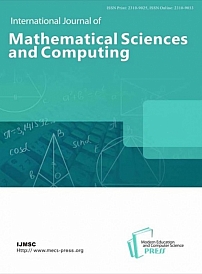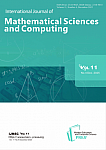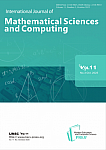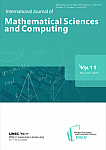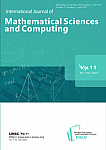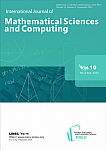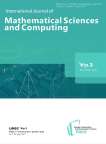International Journal of Mathematical Sciences and Computing @ijmsc
International Journal of Mathematical Sciences and Computing
International Journal of Mathematical Sciences and Computing (IJMSC) is a peer reviewed journal in the field of Mathematical Sciences and Computing. The journal is published 4 issues per year by the MECS Publisher. All papers will be blind reviewed. Accepted papers will be available on line (free access) and in printed version. No publication fee.
IJMSC is publishing refereed, high quality original research papers in all areas of Mathematical Sciences and Computing. IJMSC is also an open access product focusing on publishing conference proceedings, enabling fast dissemination so that conference delegates can publish their papers in a dedicated online issue.
IJMSC has been indexed by several world class databases:Google Scholar, Microsoft Academic Search, CrossRef, CNKI, JournalTOCs, etc...
The journal publishes original papers in the field of Mathematical Sciences and Computing which covers, but not limited to the following scope:
Mathematical logic and foundations
Combinatory
Order, lattices, ordered algebraic structures
General algebraic systems
Number theory
Field theory and polynomials
Commutative rings and algebras
Algebraic geometry
Linear and multi-linear algebra; matrix theory
Associative rings and algebras
Category theory; homological algebra
Group theory and generalizations
Topological groups, Lie groups
Real functions
Measure and integration
Functions of a complex variable
MSeveral complex variables and analytic spaces
Special functions
Ordinary differential equations
Partial differential equations
Dynamical systems and ergodic theory
Difference and functional equations
Sequences, series, summability
Approximations and expansions
Fourier analysis
Integral transforms, operational calculus
Integral equations
Functional analysis
Operator theory
Calculus of variations; optimal control; optimization
Geometry
Convex and discrete geometry
Differential geometry
General topology
Algebraic topology
Global analysis, analysis on manifolds
Probability theory and stochastic processes
Statistics
Numerical analysis
Computer science
Statistical mechanics, structure of matter
Operations research, mathematical programming
Game theory, economics, social & behavioral sciences
Systems theory; control
Information and communication, circuitsMathematics education.
Modern Education & Computer Science Press
Выпуски журнала
Статьи журнала
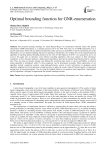
Optimal bounding function for GNR-enumeration
Статья научная
The proposed pruning technique by Gama-Nguyen-Regev for enumeration function makes this pruned enumeration (GNR-enumeration) as a claimant practical solver for SVP. The total cost of GNR-enumeration over a specific input lattice block with pre-defined enumeration radius and success probability would be minimized, just if this enumeration uses an optimal bounding function for pruning. Unfortunately, the running time of the original proposed algorithm of searching optimal bounding function by the work of Chen-Nguyen (in 2011) is not analyzed at all, so our work in this paper tries to introduce some efficient searching algorithms with exact analysis of their time/space complexity. In fact, this paper proposes a global search algorithm to generate the optimal bounding function by a greedy idea. Then, by using our greedy strategy and defining the searching steps based on success probability, a practical search algorithm is introduced, while it’s time-complexity can be determined accurately. Main superiorities of our algorithm include: complexity analysis, using high-performance version of each sub-function in designing search algorithm, jumping from local optimums, simple heuristics to guide the search, trade-off between quality of output and running time by tuning parameters. Also by using the building blocks in our practical search algorithm, a high-quality and fast algorithm is designed to approximate the optimal bounding function.
Бесплатно
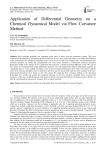
Application of Differential Geometry on a Chemical Dynamical Model via Flow Curvature Method
Статья научная
Slow invariant manifolds can contribute major rules in many slow-fast dynamical systems. This slow manifold can be obtained by eliminating the fast mode from the slow-fast system and allows us to reduce the dimension of the system where the asymptotic dynamics of the system occurs on that slow manifold and a low dimensional slow invariant manifold can reduce the computational cost. This article considers a trimolecular chemical dynamical Brusselator model of the mixture of two components that represents a chemical reaction-diffusion system. We convert this system of two-dimensional partial differential equations into four-dimensional ordinary differential equations by considering the new wave variable and obtain a new system of chemical Brusselator flow model. We observe that the onset of the chemical instability does not depend on the flow rate. We particularly study the slow manifold of the four-dimensional Brusselator flow model at zero flow speed. We apply the flow curvature method to the dynamical Brusselator flow model and acquire the analytical equation of the flow curvature manifold. Then we prove the invariance of this slow manifold equation with respect to the flow by using the Darboux invariance theorem. Finally, we find the osculating plane equation by using the flow curvature manifold.
Бесплатно
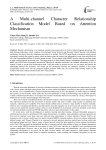
A Multi-channel Character Relationship Classification Model Based on Attention Mechanism
Статья научная
Relation classification is an important semantic processing task in the field of natural language processing. The deep learning technology, which combines Convolutional Neural Network and Recurrent Neural Network with attention mechanism, has always been the mainstream and state-of-art method. The LSTM model based on recurrent neural network dynamically controls the weight by gating, which can better extract the context state information in time series and effectively solve the long-standing problem of recurrent neural network. The pre-trained model BERT has also achieved excellent results in many natural language processing tasks. This paper proposes a multi-channel character relationship classification model of BERT and LSTM based on attention mechanism. Through the attention mechanism, the semantic information of the two models is fused to get the final classification result. Using this model to process the text, we can extract and classify the relationship between the characters, and finally get the relationship between the characters included in this paper. Experimental results show that the proposed method performs better than the previous deep learning model on the SemEval-2010 task 8 dataset and the COAE-2016-Task3 dataset.
Бесплатно
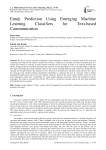
Emoji Prediction Using Emerging Machine Learning Classifiers for Text-based Communication
Статья научная
We aim to extract emotional components within statements to identify the emotional state of the writer and assigning emoji related to the emotion. Emojis have become a staple part of everyday text-based communication. It is normal and common to construct an entire response with the sole use of emoji. It comes as no surprise, therefore, that effort is being put into the automatic prediction and selection of emoji appropriate for a text message. Major companies like Apple and Google have made immense strides in this, and have already deployed such systems into production (for example, the Google Gboard). The proposed work is focused on the problem of automatic emoji selection for a given text message using machine learning classification algorithms to categorize the tone of a message which is further segregated through n-gram into one of seven distinct categories. Based on the output of the classifier, select one of the more appropriate emoji from a predefined list using natural language processing (NLP) and sentimental analysis techniques. The corpus is extracted from Twitter. The result is a boring text message made lively after being annotated with appropriate text messages
Бесплатно

